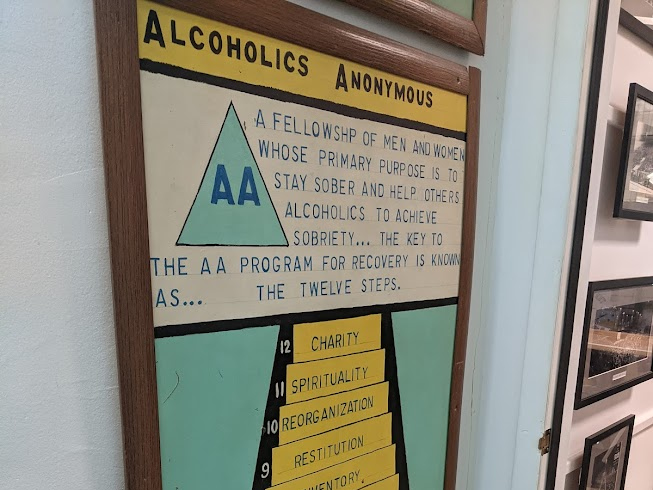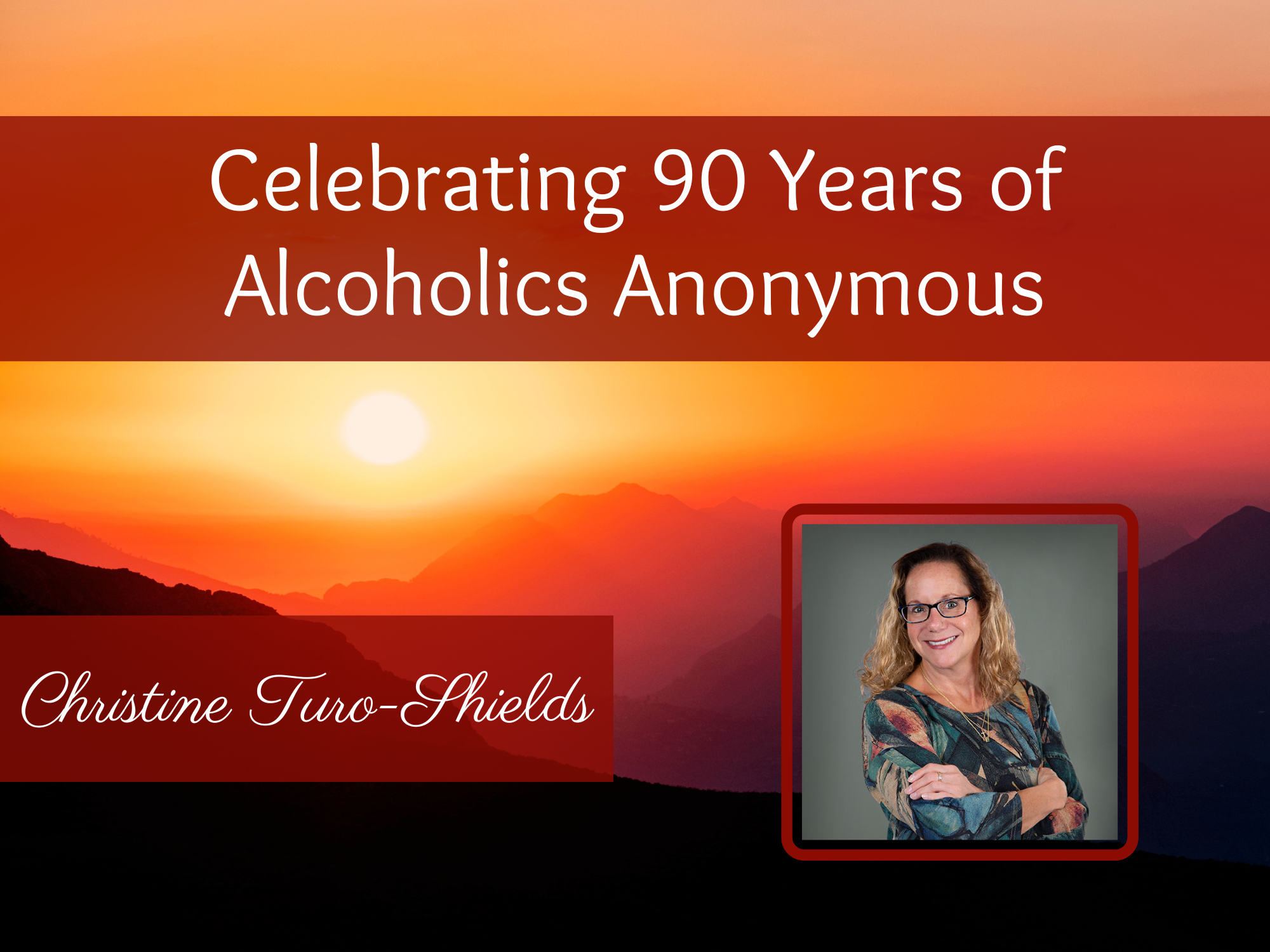The following personal essay was written by Christine Turo-Shields, co-founder and owner of Kenosis Counseling Center.
Today, June 10th, stands as a significant date for me, both personally and professionally.
June 10th is known as Founders Day in Alcoholics Anonymous (AA) circles, and today in 2025, it marks the 90th anniversary of the inception of AA—the date in 1935 when co-founder Dr. Bob took his last drink.
Even as a non-alcoholic, AA has been transformational for me from my earliest years.

My Introduction to Alcoholics Anonymous
I was only 4 years old when my mom started attending AA in 1969. In 1978, she took her last drink.
There was much turbulence in my family due to my mom’s alcoholism, but I learned some valuable lessons throughout those young years which would shape my perspective of people as well as unfold my entire future professional life:
- Alcoholism is a disease, not a defect of character nor a moral failing.
- Alcoholism does not discriminate based on race, sex, religion, educational status, profession, financial status, etc. Anyone can struggle with alcoholism as it is an “equal opportunity destroyer”.
- Those who do struggle with the disease still have value. Two of my mom’s closest friends were Arlene & Ed, both of whom were chronic drunks, but they were welcomed in our home and treated with respect.
- Some (maybe most) are born with the disease. My mom shared that she knew she was alcoholic the very first time she drank (which was actually in adulthood after she met my dad).
- Alcoholism is a “chronic, progressive and potentially fatal disease”.
- AA is a place where people find support, hope and connection.
I was unaware at the time of the deep impact that my mom’s alcoholism and recovery had on me. However, I came to learn, grow and internalize the wisdom of recovery through the 12 Steps in my own life.
Those vital life lessons were further implanted in my very being when I began volunteering at the impressionable age of 19.

Learning to Live the AA Way
I credit Donald Garnett, an incredible human who was the essence of recovery, for keeping me in the addictions field.
Donald was the executive director of Gaudenzia Concept 90 (or “Concept 90”), which to this day remains a 90-day residential addictions treatment center in my home state of Pennsylvania. I had no idea what I would encounter when I signed up to volunteer at Concept 90, and I soon felt very ill-equipped in the presence of the residents.
I shared with Donald that I didn’t think I could do this work because I was not an addict or alcoholic. I felt that I had nothing to offer. He paused, then responded with quiet wisdom, asking me two simple questions:
“Can you feel pain?” Yes, I answered.
“Do you have to have cancer to work with cancer patients?” No, I answered.
“Pain is pain,” he concluded. “That is where you connect with others.”
His simple but profound statement kept me in the field, and 40+ years later, that is simply what I do every single day. I connect with others around their pain.
Throughout my 2 ½ years at Concept 90, my cohort group consisted of both staff and residents. Cecila, Lonnie, Linda and Tonya were the former who taught me much. However, Ira, Luther, Bev, Marvin and Virgil were among my most memorable resident teachers.
I heard their stories of pain and trauma. I sat with those who were white, brown and black; I broke bread with those who were straight, gay and lesbian; I admired those with money and those without. I sat with those who had been raped (including my first male client who was victimized while in jail); those who had sold their bodies for drugs; one who had been incarcerated for murder. They showed themselves to me, including the tragedies that pierced their lives.
I came to know them. Each one of them became family. I came to love them as I witnessed their transformation through the 12 Steps of AA and NA.
The Promises were made manifest in their lives, “sometimes quickly, sometimes slowly”, based on how they applied the 12 Steps to their lives. Every open meeting that I attended ended with the same mantra: “It works if you work it.” And many did.

Alcoholics Anonymous’ Legacy in My Life
Both during and after those years at Concept 90, slogan after slogan echoed in my brain and was etched into my heart.
I heard words that weren’t meant just for the residents; it was clear that the 12 Steps of AA applied not only to addicts and alcoholics, but to me as well. The wisdom of the 12 Steps, sharing “experience, strength and hope”, is a blueprint for life—for us all. It is truly just a good way to live.
During my own 5-day intensive ACOA (adult children of alcoholics) treatment as a 21-year-old, I was reminded that Step One starts with the word “We”, not “I”. Recovery is not done in isolation nor in a vacuum; it is done in community. And community is exactly what Bill W. and Dr. Bob created when they came together 90 years ago today.
Born out of the Oxford Group, these two hopeless alcoholics could not stay sober on their own. They came together, aided by others who identified the problem (described by Dr. Silkworth as an allergy of the body and an obsession of the mind) as well as found the solution (described by Carl Jung as a spiritual experience/phenomena), and then put the remaining steps together (as outlined by the Oxford Group).
In time, the two became 100, which became 400 by the end of 1939, which became 100,000 by 1950, which became over two million in 180 countries (and counting) as of 2021.
As I reflect on the influence of these two men on multitudes of recovering souls, I remain steadfast in my belief that Divine Providence’s hand is ever-present. God guided two hopeless drunks to the same destiny as Abraham: having descendants as numerous as the stars.
In Breathing Under Water: Spirituality and the Twelve Steps, Richard Rohr beautifully articulates the paradoxical nature of AA that makes recovery happen:
“We suffer to get well. We surrender to win.
We die to live. We give it away to keep it.”
So, on this 90th anniversary of Alcoholics Anonymous, I am eternally and deeply indebted to Bill W. and Dr. Bob and the first 100 for their persistent seeking of a solution. They were vehicles of God’s healing in the world—healing for the many millions who have been, and will be delivered, into recovery through the work of the 12 Steps.
Words cannot fully describe the depth of my gratitude, as I was not only personally touched, but even more so professionally raised, by the 12 Steps of Alcoholics Anonymous.

